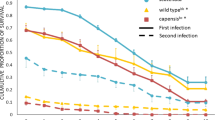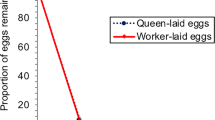Abstract
We studied the effects of mixed honeybee colonies of Apis mellifera and Apis cerana on the intraspecific and interspecific recognition of female brood stages in the honeybees A. cerana and A. mellifera by transferring brood combs between queenright colonies. In the intraspecific tests, significantly more larvae were removed in A. cerana than in A. mellifera, whilst significantly fewer eggs and pupae were removed in A. cerana than in A. mellifera. In the interspecific tests, A. cerana colonies removed significantly more larvae and pupae of A. mellifera than the same brood stages of A. cerana were removed by A. mellifera. We show there are highly significant differences in both intraspecific and interspecific brood recognition between A. cerana and A. mellifera and that brood recognition operates with decreasing intensity with increasing developmental age within species. This suggests that worker policing in egg removal is a first line of defense against heterospecific social parasites.
Zusammenfassung
Innerartliche und zwischenartliche Bruterkennung ist bei im gleichen Verbreitungsgebiet lebenden sozialen Insekten für die Sicherheit der Vermehrung und oft auch für die Integrität der Kolonien von grundlegender Bedeutung (Breed, 1998; Moritz and Neumann, 2004). Von besonderer Wichtigkeit ist sie im Kontext des Sozialparasitismus (Nanork et al., 2007b). Wir untersuchten die Auswirkungen gemischter Honigbienenvölker von Apis mellifera und Apis cerana auf die innerartliche und zwischenartliche Erkennung weiblicher Brutstadien der beiden Honigbienenarten mittels des Tauschs von Brutwaben zwischen weiselrichtigen Völkern.
In den innerartlichen Tests wurden bei A. cerana signifikant mehr Larven entfernt als bei A. mellifera, während dagegen bei A. cerana signifikant weniger Eier und Puppen entfernt wurden als bei A. mellifera. Bei den zwischenartlichen Tests entfernten A. cerana signifikant mehr Larven und Puppen von A. mellifera als die gleichen Brutstadien von A. cerana durch A. mellifera entfernt wurden. Unsere Daten bestätigen damit frühere Untersuchungen mit zwischenartlicher Brutübertragung, dass bei A. cerana und A. mellifera die Brutunterscheidung bezüglich Eiern und jungen Larven gut ausgeprägt ist (Oschmann, 1965; Dhaliwal und Atwal, 1970; Adlakha und Sharma, 1971; Oku und Ono, 1990; Potichot et al., 1993). Wie zu erwarten, verhielten sich die gemischtartigen Völker in ihrem Brutentfernungsverhalten zwischen dem innerartlichen und zwischenartlichen Austausch der reinen Völker. Sie entfernten signifikant weniger heterospezifische Brut im Vergleich zu reinen Völkern, aber mehr als bei innerspezifischem Austausch. Unter der Annahme von ähnlichem Sammelverhalten von A. cerana und A. mellifera (Devkota und Thapa, 2005) legt dies nahe, dass die Zusammensetzung der Arbeitsbienen einen Einfluss auf die Bruterkennung bei Honigbienen hat und die genetischen Auslöser der Bruterkennung denen der Erkennung von Nestgenossen bei Arbeiterinnen ähnlich sind (Breed, 1998; Moritz and Neumann, 2004).
Die Erkennung von Nestgenossen bei Arbeiterinnen hängt zu wechselnden Anteilen von der Außenumgebung und der Genetik ab (Breed, 1998), allerdings zeigen unsere Daten, dass diese sich nicht unbedingt in gleicher Weise auf die Eier und immature Stadien auswirken. Da bereits zuvor vermutete Pheromone zur Erkennung von Brut und Eiern (Potichot et al., 1993) kürzlich bestätigt wurden (Ayasse and Paxton, 2002; Sasaki et al., 2004), nehmen wir an, dass spezifische Pheromone der Eier und Larven eine grundlegende Rolle bei den sowohl bei gleichartigen als auch bei zwischenartigem Austausch beobachteten hohen Entfernungsraten der fremden Eiere und Larven spielen. Unter diesen experimentellen Bedingungen schien die Bruterkennung mit steigendem Entwicklungsalter in der Intensität abzunehmen, aber in jedem Alter durch die genetische Distanz verstärkt zu werden.
Similar content being viewed by others
References
Adlakha R.L., Sharma O.P. (1971) Interspecific introduction of queens (Apis mellifera queens into A. indica nuclei), Proc 23rd Int. Apic. Congr., Moscow, Apimondia, p. 402.
Aichholz R., Lorbeer E., Hüttinger E. (2000) The chemical compounds of beeswax from Apis species, Proc. 4th Asian Apic. Assoc. Conf., Kathmandu, pp. 152–154.
Alexander B.A. (1991) A cladistic analysis of the genus Apis, in: Smith D.R. (Ed.), Diversity of the Genus Apis, Westview Press, Boulder, pp. 1–28.
Arias M.C., Sheppard W.S. (2005) Phylogenetic relationships of honey bees (Hymenoptera: Apinae: Apini) inferred from nuclear and mitochondrial DNA sequence data, Mol. Phylogenet. Evol. 37, 25–35.
Atwal A.S., Sharma O.P. (1967) The introduction of Apis mellifera queens into Apis indica colonies and the associated behavior of the two species, Proc. 21st Int. Beekeep. Congr. Prelim. Mtg. Summary paper 70, 77.
Ayasse M., Paxton R.J. (2002) Brood protection in social insects, in: Hilker M., Meinders T. (Eds.), Chemoecology of insect eggs and egg deposition, Blackwell Science, Oxford, pp. 117–148.
Bethe A. (1898) Should we credit ants and honeybees with personality traits?, Pflug. Arch. Ges. Physiol. 70, 15–100 [in German].
Breed M.D. (1998) Recognition pheromones of the honey bee, BioSciences 48, 463–470.
Breed M.D., Stiller T.M. (1992) Honey bee, Apis mellifera, nestmate discrimination: hydrocarbon effects and the evolutionary implications of comb choice, Anim. Behav. 43, 875–883.
Breed M.D., Williams K.R., Fewell J.H. (1988) Comb wax mediates the acquisition of nest-mate recognition cues in honey bees, Proc. Natl. Acad. Sci. 85, 8766–8769.
Breed M.D., Page R.E., Hibbard B.E., Bjostad L.K.B. (1995) Interfamily variation in comb wax hydrocarbons produced by honey bees, J. Chem. Ecol. 21, 1329–1338.
Breed M.D., Perry S., Bjostad L.K.B. (2004) Testing the blank slate hypothesis: why honey bee colonies accept young bees, Insectes Soc. 51, 12–16.
D’Ettorre P., Wenseleers T., Dawson J. (2006) Wax combs mediate nestmate recognition by guard honeybees, Anim. Behav. 71, 773–779.
Dhaliwal G.S., Atwal A.S. (1970) Interspecific relations between Apis cerana indica and Apis mellifera, J. Apic. Res. 9, 53–59.
Devkota F.R., Thapa R.B. (2005) Foraging preference of Apis cerana F. and Apis mellifera, J. Inst. Agric. Anim. Sci. 26, 167–168.
Free J.B. (1987) Pheromones of Social Bees, Chapman and Hall, London.
Grout R.A. (Ed.) (1946) The Hive and the Honey Bee, Dadant and Sons, Hamilton.
Inoue A. (1962) Preliminary report on the rearing of Japanese honeybee queens in colonies of the European honeybee, Indian Bee J. 24, 73–74.
Johnson R.A., Wichern D.W. (2002) Applied multivariate statistical Analysis, 5th Edition, Prentice Hall, Upper Saddle River, New Jersey.
Katzav-Gozansky T., Soroker V., Kamer J., Schulz C.M., Francke W., Hefetz A. (2003) Ultrastructural and chemical characterization of egg surface of honeybee worker and queen-laid eggs, Chemoecology 13, 129–134.
Koeniger G., Koeniger N., Tingek S. (1994) Cross fostered drones of Apis cerana (Fabricius, 1793) and Apis koschevnikovi (Buttel-Reepen, 1906) fly at their species specific mating times, Insectes Soc. 41, 73–78.
Koeniger N., Koeniger G., Tingek S., Kelitu A. (1996) Interspecific rearing and acceptance of queens between Apis cerana Fabricius, 1793 and Apis koschevnikovi Buttel-Reepen, 1906, Apidologie 27, 371–380.
Le Conte Y., Sreng L., Trouiller J. (1994) The recognition of larvae by worker honeybees, Naturwissenschaften 81, 462–465.
Le Conte Y., Sreng L., Poitout S.H. (1995) Brood pheromone can modulate the feeding behavior of Apis mellifera workers (Hymenoptera: Apidae), J. Econ. Entomol. 88, 798–804.
Martin S.J., Dils V., Billen J. (2005) Morphology of the Dufour gland within the honey bee sting gland complex, Apidologie 36, 543–546.
Mori A., D’Ettorre P., Le Moli F. (1996) Selective acceptance of the brood of two formicine slave-making ants by host and non-host related species, Insectes Soc. 43, 391–400.
Moritz R.F.A., Neumann P. (2004) Differences in nestmate recognition for drones and workers in the honeybee. Apis mellifera (L.), Anim. Behav. 67, 681–688.
Nakamura J. (1994) Absconding as an adaptive behaviour of the Asian honey bee, Apis cerana. Bull. Fac. Agric. Tamagawa Univ. 34, 81–102 [In Japanese].
Nanork, P., Wongsiri, S., Oldroyd B.P. (2007a) Preservation and loss of the honey bee (Apis) egg-marking signal across evolutionary time, Behav. Ecol. Sociobiol. 61, 1509–1514.
Nanork P., Chapman N.C., Wongsiri S., Lim J., Gloag R.S., Oldroyd B.P. (2007b) Social parasitism by workers in queenless and queenright Apis cerana colonies, Mol. Ecol. 16, 1107–1114.
Neumann P., Moritz R.F.A. (2002) The Cape honeybee phenomenon: the sympatric evolution of a social parasite in real time? Behav. Ecol. Sociobiol. 52, 271–281.
Oku N., Ono M. (1990) Preliminary attempts to rear larvae of the Japanese honeybee, Apis cerana japonica, in an Apis mellifera colony and in the laboratory using A. mellifera royal jelly, Honeybee Sci. 11, 121–124 [In Japanese].
Oschmann H. (1965) Can Apis mellifica bees rear brood of A. cerana? Die Biene, Giessen 101, 150–151 [In German].
Pirk C.W.W., Neumann P., Hepburn H.R. (2007) Nestmate recognition for eggs in the honeybee (Apis mellifera L.), Behav. Ecol. Sociobiol. 61, 1685–1693.
Potichot S., Wongsiri S., Dietz A. (1993) Attempts in queen rearing of Apis cerana larvae in Apis mellifera colonies and Apis mellifera larvae in Apis cerana colonies, in: Connor L.J., Rinderer T.E., Sylvester H.A., Wongsiri S. (Eds.), Asian Apiculture, Wicwas Press, Cheshire, pp. 128–133.
Ratnieks F.L.W. (1992) Evidence for an egg-marking pheromone in the honeybee, Am. Bee J. 132, 813.
Ribbands C.R. (1954) The defence of the honeybee community, Proc. R. Soc. B 142, 512–524.
Ruttner F. (1988) Biogeography and taxonomy of honeybees, Springer-Verlag, Berlin.
Sakagami S. (1959) Some interspecific relations between Japanese and European honeybees, J. Anim. Ecol. 28, 51–68.
Sasaki K., Kitamura H., Obara Y. (2004) Discrimination of larval sex and timing of male brood elimination by workers in honeybees (Apis mellifera L.), Appl. Entomol. Zool. 39, 393–399.
Smith D.R. (1991) Mitochondrial DNA and honey bee biogeography, in: Smith D.R. (Ed.), Diversity in the Genus Apis, Westview, Boulder, pp. 131–176.
StatSoft Inc. (2007) STATISTICA, version 8.1. www.statsoft.com.
Spiewok S., Neumann P., Hepburn H.R. (2006) Preparation for disturbance-induced absconding of Cape honeybee colonies (Apis mellifera capensis Esch.), Insectes Soc. 53, 27–31.
Tan K., Hepburn H.R., He S., Radloff S.E., Neumann P., Fang X. (2006) Gigantism in honeybees: Apis cerana queens reared in mixed-species colonies, Naturwissenschaften 93, 315–320.
Visscher P.K. (1986) Kinship discrimination in queen rearing by honey bees (Apis mellifera), Behav. Ecol. Sociobiol. 18, 453–460.
Author information
Authors and Affiliations
Corresponding author
Additional information
Manuscript editor: Stan Schneider
Rights and permissions
About this article
Cite this article
Tan, K., Yang, M., Radloff, S.E. et al. Intra- and interspecific brood recognition in pure and mixed-species honeybee colonies, Apis cerana and A. mellifera . Apidologie 40, 184–191 (2009). https://doi.org/10.1051/apido/2009003
Received:
Revised:
Accepted:
Issue Date:
DOI: https://doi.org/10.1051/apido/2009003




